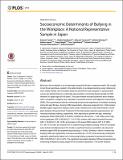| dc.contributor.author | Tsuno, Kanami | en_US |
| dc.contributor.author | Kawakami, Norito | en_US |
| dc.contributor.author | Tsutsumi, Akizumi | en_US |
| dc.contributor.author | Shimazu, Akihito | en_US |
| dc.contributor.author | Inoue, Akiomi | en_US |
| dc.contributor.author | Odagiri, Yuko | en_US |
| dc.contributor.author | Yoshikawa, Toru | en_US |
| dc.contributor.author | Haratani, Takashi | en_US |
| dc.contributor.author | Shimomitsu, Teruichi | en_US |
| dc.contributor.author | Kawachi, Ichiro | en_US |
| dc.date.accessioned | 2015-04-01T15:25:47Z | |
| dc.date.issued | 2015 | en_US |
| dc.identifier.citation | Tsuno, Kanami, Norito Kawakami, Akizumi Tsutsumi, Akihito Shimazu, Akiomi Inoue, Yuko Odagiri, Toru Yoshikawa, Takashi Haratani, Teruichi Shimomitsu, and Ichiro Kawachi. 2015. “Socioeconomic Determinants of Bullying in the Workplace: A National Representative Sample in Japan.” PLoS ONE 10 (3): e0119435. doi:10.1371/journal.pone.0119435. http://dx.doi.org/10.1371/journal.pone.0119435. | en |
| dc.identifier.issn | 1932-6203 | en |
| dc.identifier.uri | http://nrs.harvard.edu/urn-3:HUL.InstRepos:14351086 | |
| dc.description.abstract | Bullying in the workplace is an increasingly recognized threat to employee health. We sought to test three hypotheses related to the determinants of workplace bullying: power distance at work; safety climate; and frustration related to perceived social inequality. A questionnaire survey was administered to a nationally representative community-based sample of 5,000 residents in Japan aged 20–60 years. The questionnaire included questions about employment, occupation, company size, education, household income, and subjective social status (SSS). We inquired about both the witnessing and personal experience of workplace bullying during the past 30 days. Among 2,384 respondents, data were analyzed from 1,546 workers. Multiple logistic regression analyses were used to examine the social determinants of workplace bullying. Six percent and 15 percent of the total sample reported experiencing or witnessing workplace bullying, respectively. After adjusting for gender and age, temporary employees (Odds Ratio [OR]: 2.45 [95% Confidence Interval (CI) = 1.03–5.85]), junior high school graduates (OR: 2.62 [95%CI: 1.01–6.79]), workers with lowest household income (OR: 4.13 [95%CI:1.58–10.8]), and workers in the lowest SSS stratum (OR: 4.21 [95%CI:1.66–10.7]) were at increased risk of experiencing workplace bullying. When all variables were entered simultaneously in the model, a significant inverse association was observed between higher SSS and experiencing bullying (p = 0.002). Similarly in terms of witnessing bullying; SSS was significantly inversely associated (p = 0.017) while temporary employees reported a significantly higher risk of witnessing bullying compared to permanent workers (OR: 2.25 [95%CI:1.04 to 4.87]). The significant association between SSS and experiencing/witnessing workplace bullying supports the frustration hypothesis. The power distance hypothesis was also partly supported by the finding that temporary employees experienced a higher prevalence of workplace bullying. | en |
| dc.language.iso | en_US | en |
| dc.publisher | Public Library of Science | en |
| dc.relation.isversionof | doi:10.1371/journal.pone.0119435 | en |
| dc.relation.hasversion | http://www.ncbi.nlm.nih.gov/pmc/articles/PMC4353706/pdf/ | en |
| dash.license | LAA | en_US |
| dc.title | Socioeconomic Determinants of Bullying in the Workplace: A National Representative Sample in Japan | en |
| dc.type | Journal Article | en_US |
| dc.description.version | Version of Record | en |
| dc.relation.journal | PLoS ONE | en |
| dash.depositing.author | Kawachi, Ichiro | en_US |
| dc.date.available | 2015-04-01T15:25:47Z | |
| dc.identifier.doi | 10.1371/journal.pone.0119435 | * |
| dash.contributor.affiliated | Kawachi, Ichiro | |


